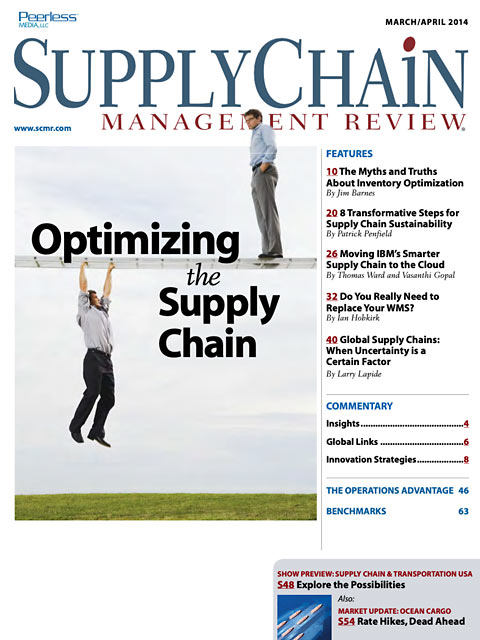Sorry, but your login has failed. Please recheck your login information and resubmit. If your subscription has expired, renew here.
March-April 2014
Retailers and distributors alike have attempted to solve their inventory challenges by using forecasting tools to determine what to buy and when to buy it. A better approach is to change the flow of inventory by reducing cycle times, more effective inventory positioning, and synchronizing supply chains based on the variability of demand. Browse this issue archive.Need Help? Contact customer service 847-559-7581 More options
The future ain’t what it used to be.” That somewhat nonsensical quote from the former New York Yankee baseball player Yogi Berra was the whimsical, yet apropos tagline for the MIT Supply Chain 2020 (SC2020) Project. I managed the project’s launch in 2004, and it continues today, focusing on what excellent supply chains would look like 10 to 15 years in the future.
Having come from a largely consulting background prior to joining MIT’s Center for Transportation & Logistics, I initially thought that successful supply chains in the future would leverage best practice trends that I had been seeing over the past five to 10 years, such as Just-in-Time (JIT) and lean operations as well as supply chain visibility and collaboration. After peeking into the future for a while, I realized these trends were based upon where the world had been recently moving, not necessarily on where it might be in the future. And, these so-called best practices might be rendered useless. I came to realize that my own view of the future “wasn’t what it used to be;” hence, the genesis of the SC2020 Project tagline.
The MIT team decided to approach the project using a Scenario Planning methodology, rather than try to do the impossible and predict the state of the world 10 to 15 years out. Our interests moved to identifying reasonable scenarios for the future, such as the worlds that supply chains might be operating in as well as the uncertainties around them. The six major factors that we feel will most affect future supply chains are: 1) the aging of developed countries; 2) oil prices; 3) a power shift toward the East; 4) trading bloc formation; 5) globalized Green Laws; and 6) pervasive technologies.
 |
This complete article is available to subscribers
only. Click on Log In Now at the top of this article for full access. Or, Start your PLUS+ subscription for instant access. |
Not ready to subscribe, but need this article?
Buy the complete article now. Only $20.00. Instant PDF Download.
Access the complete issue of Supply Chain Management Review magazine featuring
this article including every word, chart and table exactly as it appeared in the magazine.
SC
MR
Sorry, but your login has failed. Please recheck your login information and resubmit. If your subscription has expired, renew here.
March-April 2014
Retailers and distributors alike have attempted to solve their inventory challenges by using forecasting tools to determine what to buy and when to buy it. A better approach is to change the flow of inventory by… Browse this issue archive. Access your online digital edition. Download a PDF file of the March-April 2014 issue.
 |
Download Article PDF |
The future ain’t what it used to be.” That somewhat nonsensical quote from the former New York Yankee baseball player Yogi Berra was the whimsical, yet apropos tagline for the MIT Supply Chain 2020 (SC2020) Project. I managed the project’s launch in 2004, and it continues today, focusing on what excellent supply chains would look like 10 to 15 years in the future.
Having come from a largely consulting background prior to joining MIT’s Center for Transportation & Logistics, I initially thought that successful supply chains in the future would leverage best practice trends that I had been seeing over the past five to 10 years, such as Just-in-Time (JIT) and lean operations as well as supply chain visibility and collaboration. After peeking into the future for a while, I realized these trends were based upon where the world had been recently moving, not necessarily on where it might be in the future. And, these so-called best practices might be rendered useless. I came to realize that my own view of the future “wasn’t what it used to be;” hence, the genesis of the SC2020 Project tagline.
The MIT team decided to approach the project using a Scenario Planning methodology, rather than try to do the impossible and predict the state of the world 10 to 15 years out. Our interests moved to identifying reasonable scenarios for the future, such as the worlds that supply chains might be operating in as well as the uncertainties around them. The six major factors that we feel will most affect future supply chains are: 1) the aging of developed countries; 2) oil prices; 3) a power shift toward the East; 4) trading bloc formation; 5) globalized Green Laws; and 6) pervasive technologies.
 |
SUBSCRIBERS: Click here to download PDF of the full article. |
SC
MR

Latest Supply Chain News
- Joseph Esteves named CEO of SGS Maine Pointe
- Employees, employers hold divergent views on upskilling the workforce
- April manufacturing output slides after growing in March
- Q1 sees a solid finish with positive U.S.-bound import growth, notes S&P Global Market Intelligence
- World Trade Centers offers a helping hand to create resilient, interconnected supply chains
- More News
Latest Podcast

 Explore
Explore
Topics
Latest Supply Chain News
- Joseph Esteves named CEO of SGS Maine Pointe
- Employees, employers hold divergent views on upskilling the workforce
- April manufacturing output slides after growing in March
- Q1 sees a solid finish with positive U.S.-bound import growth, notes S&P Global Market Intelligence
- World Trade Centers offers a helping hand to create resilient, interconnected supply chains
- 6 Questions With … Sandeep Bhide
- More latest news
Latest Resources

Subscribe

Supply Chain Management Review delivers the best industry content.

Editors’ Picks





